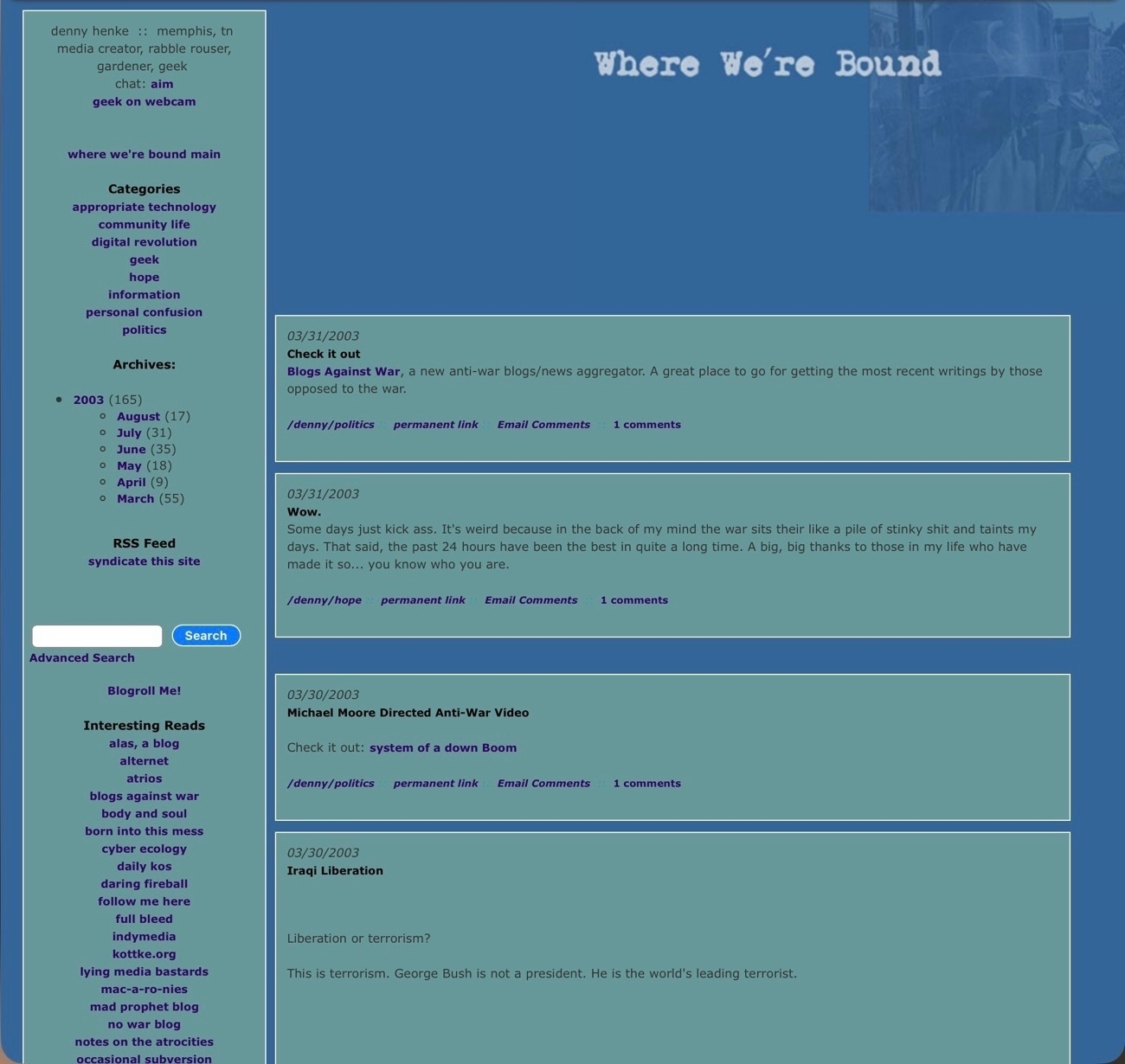Technology
- I do own a car but miles driven over the past year are very low at 150. 300 miles over past two years. Only driving necessary trips for groceries/supplies from town. Around 10 trips per year.
- Continue to conserve electricity as much as possible. Example data, it's 55° in cabin this morning. Winter is easier as it's no problem to just add layers as needed. Even at 55-60° I'm cozy and comfortable. Summer is more difficult. Lots of humidity in Missouri but summer temps have been lower than what most have had to contend with the past few years. In any case, as with heating, cooling a smaller space is less energy. I try to keep it between 76-80. Probably averaging 77-78 most days.
- I've not traveled by air in 20 years.
- I have no kids and at 54, single and having had a vasectomy several years ago it's assured I'l continue to not have any.
- My diet is nearly vegan. I do ice cream, occasional cheese, occasional eggs, occasional fish. A note about meat: I don't buy it but if my family are offering fish caught locally I'll eat some of that. Also, if left-over meat of almost any kind is going to get thrown away I'll eat it so it's not wasted.
- I do most outdoor work by hand. As mentioned above, most road work this past fall was with no fossil fuels. My uncle has a tractor and I did help him with his section of road. I worked by hand and helped direct him on the tractor. Surprisingly some things are actually better done with hand tools. I try to minimize grass lawn but I do have some to cut. Also, areas where invasive lespedeza has moved in has to be mowed. I use a battery/electric mower that's charged with solar panels.
- Re-use and recycling. I continue my trend of few to no clothing purchases. Between clothing given to me by folks that are cleaning storage/closets I usually have far more than I need. I've nearly eliminated hard plastic packaging from store bought items. With just one or two exceptions everything I buy comes recyclable steel or in paper or paperboard that I compost. Some food comes in pastic bags (lentils, beans, tortillas) but that's about it. I've recently discovered the joys of waffles made from flour and a waffle iron. I'm not a big bread eater but I'm going to try to use waffes as a bread substitute.
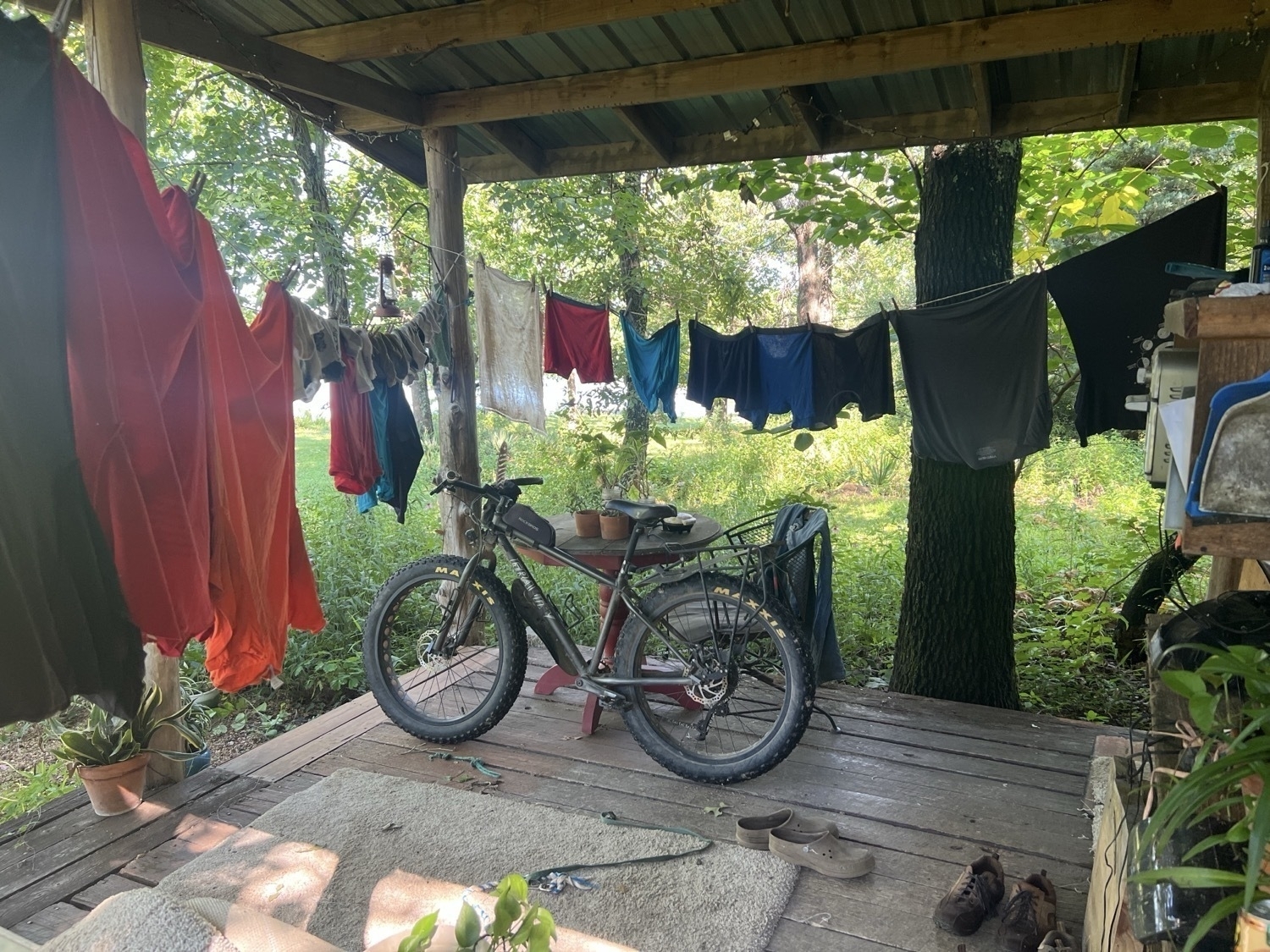
Tiny Life Journal - Laundry day! I don't wash clothes nearly as often as most do. And I keep clothes until they are thin and falling apart. Many of my shirts have holes in them. Also, hang dry is a free, low-tech way to use the sun.
The intensification of the climate emergency by tech, particularly AI, should be front and center in the reporting but it's not. An exception: Nvidia's Computex 2024 keynote terrified TechRadar's John Loeffler.
There was something that Huang said during the keynote that shocked me into a mild panic. Nvidia's Blackwell cluster, which will come with eight GPUs, pulls down 15kW of power. That's 15,000 watts of power. Divided by eight, that's 1,875 watts per GPU.
The current-gen Hopper data center chips draw up to 1,000W, so Nvidia Blackwell is nearly doubling the power consumption of these chips.
Microsoft’s Emissions Spike 29% as AI Gobbles Up Resources | PCMag
What good is AI if you don’t have a planet to use it on?
Microsoft released its 2024 Sustainability Report on Wednesday, and it’s mostly bad news. Last year, Microsoft’s emissions went up 29%, and it used 23% more water, primarily due to “new technologies, including generative AI.”
…It’s now full steam ahead on selling the Copilot AI assistant add-on for Microsoft 365 products while building a new AI model that consumes tons of electricity during the training phase alone.
We need to support social justice in tech. Solidarity. An excellent post by Ben Werdmuller: No tech for apartheid is within its rights to protest | Werd.io
There is nothing honorable about supporting your employer as it commits or facilitates human rights violations. Protesting is the ethical thing to do…
Human rights should always trump business.
2023 Year in Review (Also, a few interior photos of my tiny house, pardon the mess😂)
My life is generally best characterized as small, slow and steady, I suspect a sharp contrast to most. If you're someone primarily interested in a tech oriented accounting you should skip to the last section. What comes before that is fairly comprehensive and even a bit philosophical in nature. I'm mostly writing this for myself so it's chock-full of details most people likely won't be interested in.
Home and Landscape
I live in a 200 sq ft tiny house that doesn't need much in the way of maintenance or improvements. I often make small adjustments to the arrangement of the space.
The more significant work is spent outside managing various aspects of the landscape. My garden has been small to nonexistent the past couple of years but I still end up spending a lot of time with various projects. This year it was transplanting blackberries and then, later, keeping them alive during a bit of early summer drought. Then daily harvesting in July.
In late August after a third extreme rainfall event and increasing run-off damage to our gravel roads I decided to take care of some long over-due maintenance. As I don't have a tractor this was my daily exercise, 1-2 hours a day. When I started I was unsure of the scope of the work. My intent was to start with the most problematic 40 feet of road and if it went well to continue on to another section. That first section went very well and I had it completed in 4 days. I ended up working on the remaining damaged sections through early December. I'd estimate 90 days averaging About 1.5 hours a day. It went very well. Various sections of road and driveway are much improved and the exercise generally felt very good. There's more to do but I'm taking a break now that it's gotten colder and the road is somewhat frozen.
Another fall project was clearing out several years worth of growth around our well house. I live in the woods and love it. I'm not in the habit of aggressively cutting back trees, shrubs, vines unless there's a reason to do so. This fall some new forest critters decided to make their homes in our shed and well house. Wood rats! These are about the size of squirrels but without the fuzzy tails.
I started noticing nests and food caches of acorns and wild grapes appearing in both my shed and the well house. I removed them and started taking steps to remove any sense of comfort my little friends had in these spaces. I decluttered the shed and made a point of just being out there a bit for a week. It's an old shed, somewhat open to the environment. Not sealed off tightly. My strategy worked.
The well house was another situation. Autumn olive bushes, wild grapes and honeysuckle had crept in all around the well house. The thick growth right up to the building was perfect for my friends. Food, cover, and nesting material. I don't spend much time in the well house but check it in the fall to prepare for winter. That's when I discovered my friends had started moving in.
It prompted me to take a closer look at the building and the surroundings. Where previously I'd seen the approaching mini-forest as a welcome wind break and habitat for birds (hummingbirds like to nest in the thick growth) I now had to reckon with the fact that it was also habitat for these new neighbors that were very determined to get inside the building and build nests. I sorted out their various access points and started patching old wood they had chewed through. And during the same couple of weeks I began, reluctantly, cutting back all of the growth of the mini forest. It took about three weeks in total. I cleared the area, patched the walls, sealed the outside of the building around the crawlspace.
A final part of this project was tearing down the original, still attached mini-well house structure that had been built by others many years ago. It still served as cover for our well head and the piping into the well house. I removed that and built a much smaller structure using some salvaged wood and windows. It looks a bit like a tiny A-frame greenhouse. It will serve for this winter and will likely be replaced next year as I suspect that the larger well house is going to need some significant work.
Health
I'm still dealing with some sort of inner ear issue that began with a severe, daylong episode of vertigo in September 2022. Without a doctor I've self diagnosed as some sort of Labyrinthitis. The general cause of that condition is bacterial or viral infection. Treatment seems to be centered on steroid shots and vestibular therapy. Generally the advice is to get on living life and allow the brain to adapt. Over the past 15 months it's gotten better allowing me to do normal day-to-day.
Another symptom is tinnitus which I counter with background audio from the DarkNoise app playing 24/7. I've found a pleasant mix of crickets, creek and frogs helps a lot. The crickets are the key frequency/pattern, the frogs/creek are just there to create a pleasant background.
Other health, once I got past the first three months of intense vertigo I was able to get back to my normal routines of daily dog walks and even short 20-30 trail rides on the bike. Strangely I notice the vertigo less when riding the bike.
A last health note, I've had to be much more attentive to drinking enough water and salt intake. I've probably always taken in too much sodium and not enough water. Noticed high blood pressure a year ago. Careful now to drink a minimum of 70 ounces of fluid a day and generally have sodium intake down to 2,200 mg per day. BP has returned to normal as a result.
I'm very happy to have gotten into the habit of daily diet tracking via iPhone app as well as exercise tracking with the Apple Watch. Both devices/apps have been very helpful in making sure that I'm being honest with myself about keeping a balance.
Personal Climate-Adaption
I've been on this one for a long time but have gotten even more restrictive with myself the past 3-4 years. I'm well aware that my singular efforts are irrelevant but I do it because I believe that if we humans had solidarity with one another and the planet we could fix this problem by common, collective action. Government or no, we could fix it by helping one another live differently. So, I'll keep talking about it, encouraging others and at the end of each day I know I've acted as though we were all working together.
The top 5 cuts to make (according to data) are ones I've got covered pretty well.
Working for income
I continue to have a love-hate relationship with money. I love to hate it. But as a human living in a capitalist system I also need it. I continue to generally live far outside what is normal in terms of work and income. I was thinking about climate, biodiversity and other environmental problems in 1990 when I was 21 years old which was around the time I rejected any idea of going after the American Dream. With no kids and a very tiny dwelling I have fewer expenses. Add to this my general frugality in pursuit of limiting carbon and waste and it means I can get by with far less than most.
My freelance work continues per the usual though in recent years I've had far fewer requests for new websites. Most of my client-work is maintenance of a websites as well as a mix of document layout/design and data/spreadsheet entry. In general, slower but steady.
Tech
My tech purchasing this year was minimal. My AirPods Pro died after 3 years of use so I replaced those. I also added a small 15" portable display. My intent was to use that as a second display for the iPad when I'm working from the futon. It proved useful not only as a work-related display but I've also been using it with the AppleTV. I also added a new keyboard and mouse, both are working out very well.
I have an older LED TV for movies but I've not been using it much. As I've gotten older and my eyesight worsens I'm finding I prefer a closer screen for entertainment purposes. The reason being I also browse the web with my iPad while watching some things. The TV 10 feet away requires my glasses but reading on the iPad requires that I take off the glasses. A second display within a couple feet allows me to watch and browse without glasses. I suspect I'll be trying to find a new home to donate the tv to later this year.
In recent days it also occurred to me that I could reposition my 4K computer monitor. It was positioned at my desk but the truth is I don't sit at the desk that often so it generally goes unused. On a bit of a whim I repositioned the arm and lowered it to one of the shelves closer to my futon. It's a bit odd having such a big screen (27") so close to the futon but in a week of use I think this is where it's going to stay. I've got it hooked up to the AppleTV for movies/TV. Or, if I want to use it as a second display for the iPad I just plug in a USB C port that goes through a hub to the monitor. When not in use it is swiveled out further away from the futon.
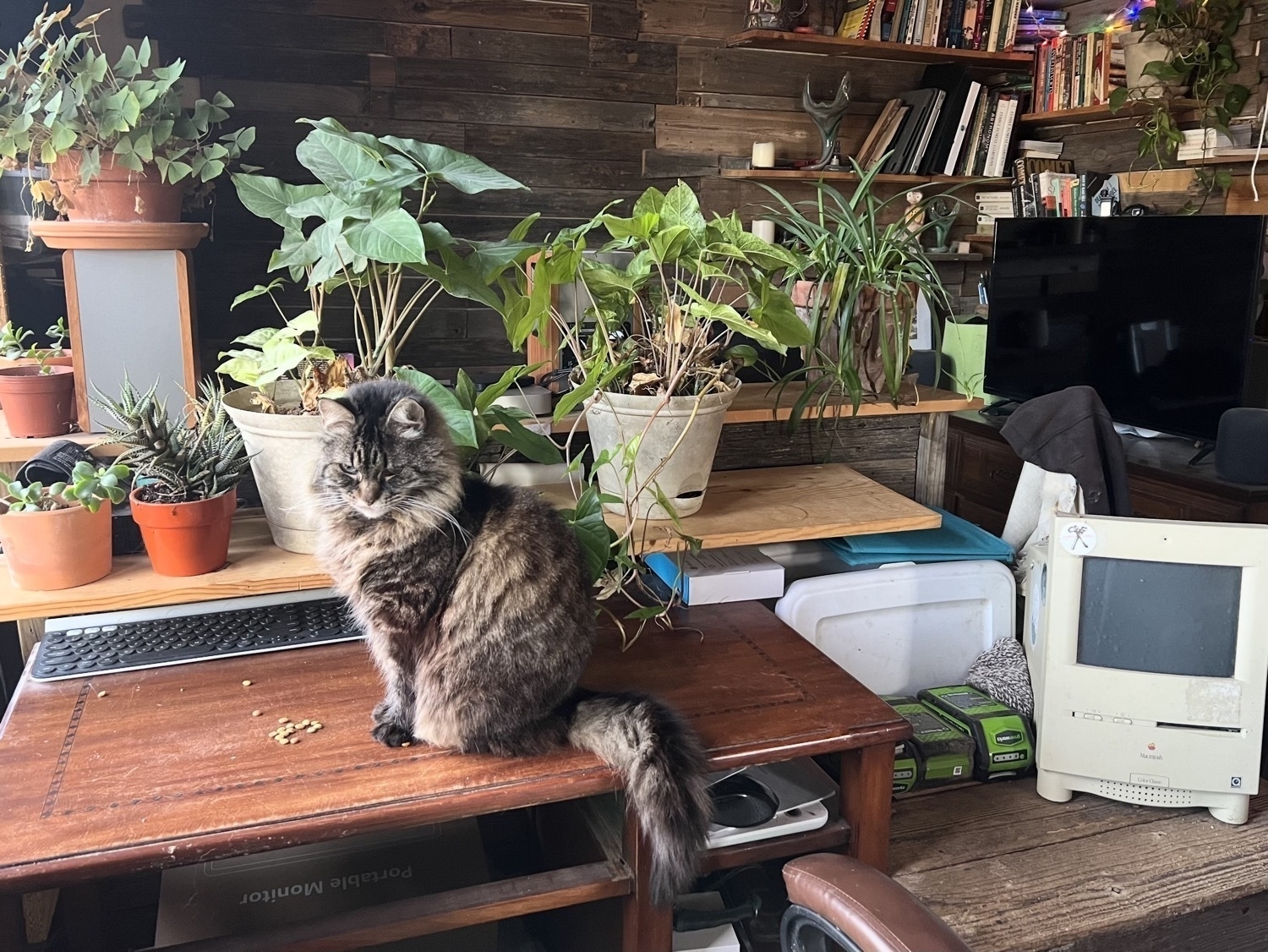
With these changes my small desk has more plants around it and is Rosie's dog-proof feeding area. The Mac Mini that is my file server/iPad back-up is in the same place and can be used with the monitor in its new location. The Mac Mini sits on the shelf/mini-wall between my desk and futon. My whole set-up is a bit weird but I attribute that to the fact that it's a one-room tiny house. It's nice though to walk into the cabin and see plants rather than a computer monitor.
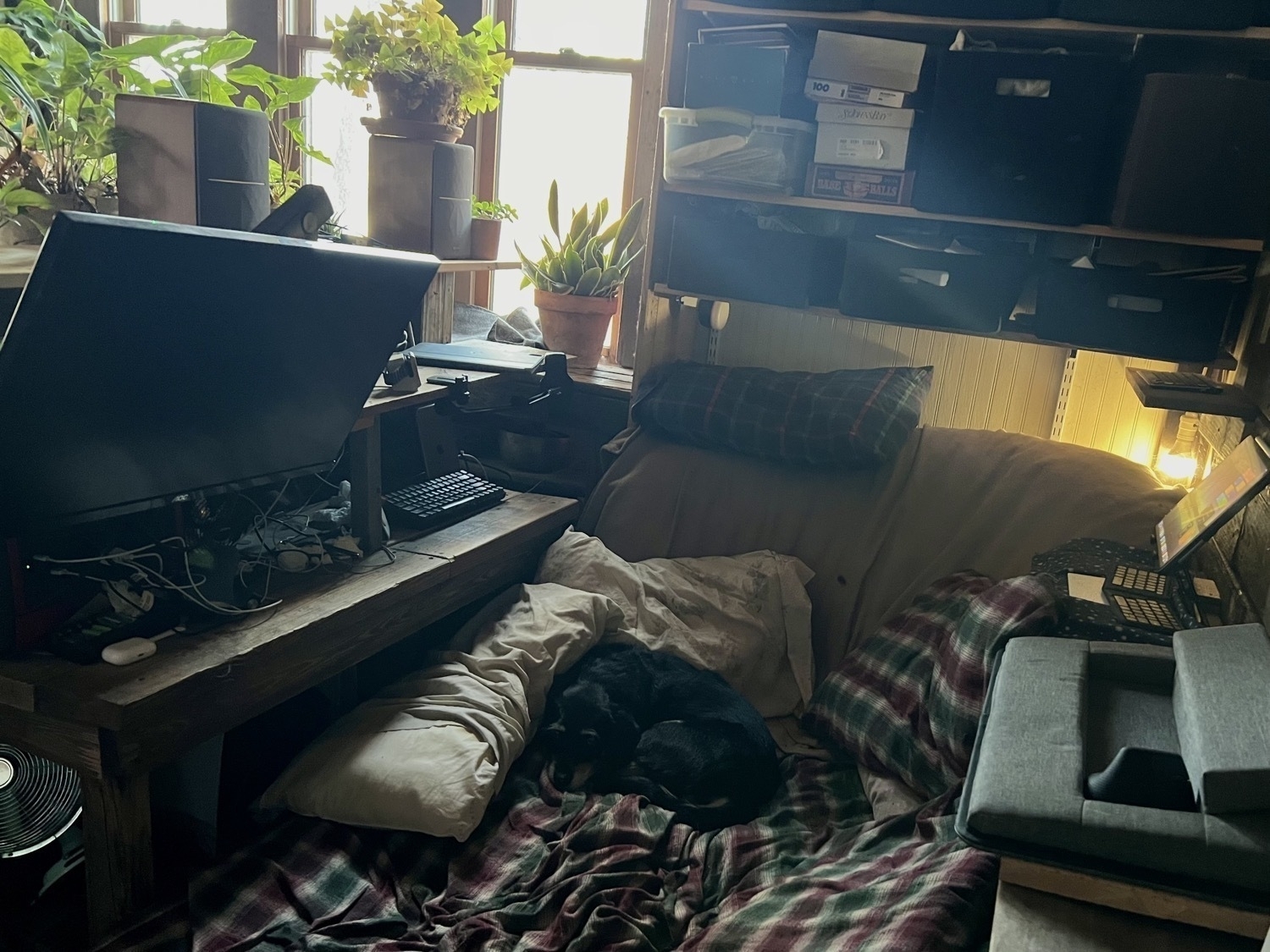
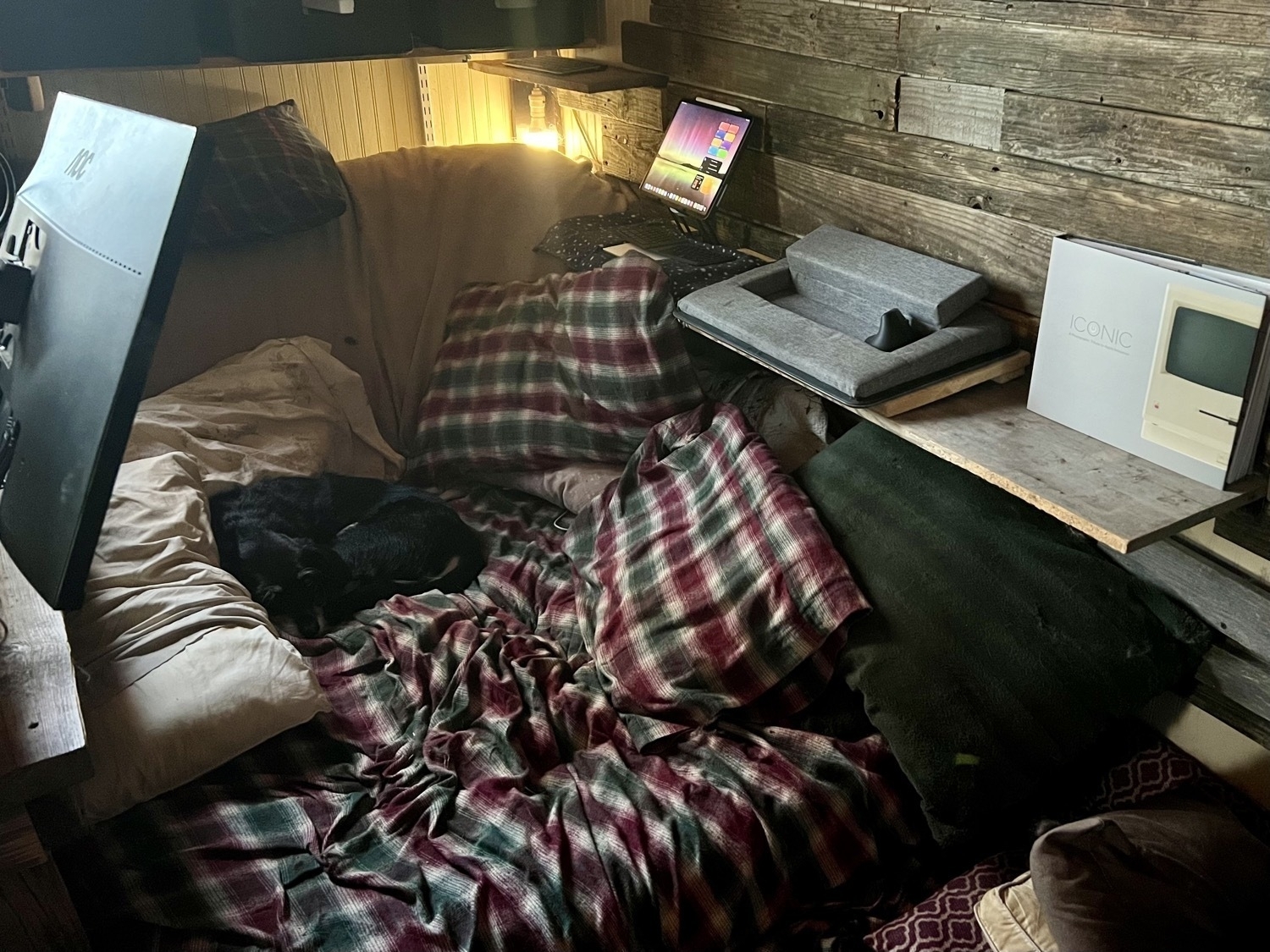 Some amazing iPad hardware is coming from Apple soon but I intend to stick with the M1 iPad as it works very well for what I need. It's only 3 years old this spring. It will likely need a new battery later this year.
Some amazing iPad hardware is coming from Apple soon but I intend to stick with the M1 iPad as it works very well for what I need. It's only 3 years old this spring. It will likely need a new battery later this year.
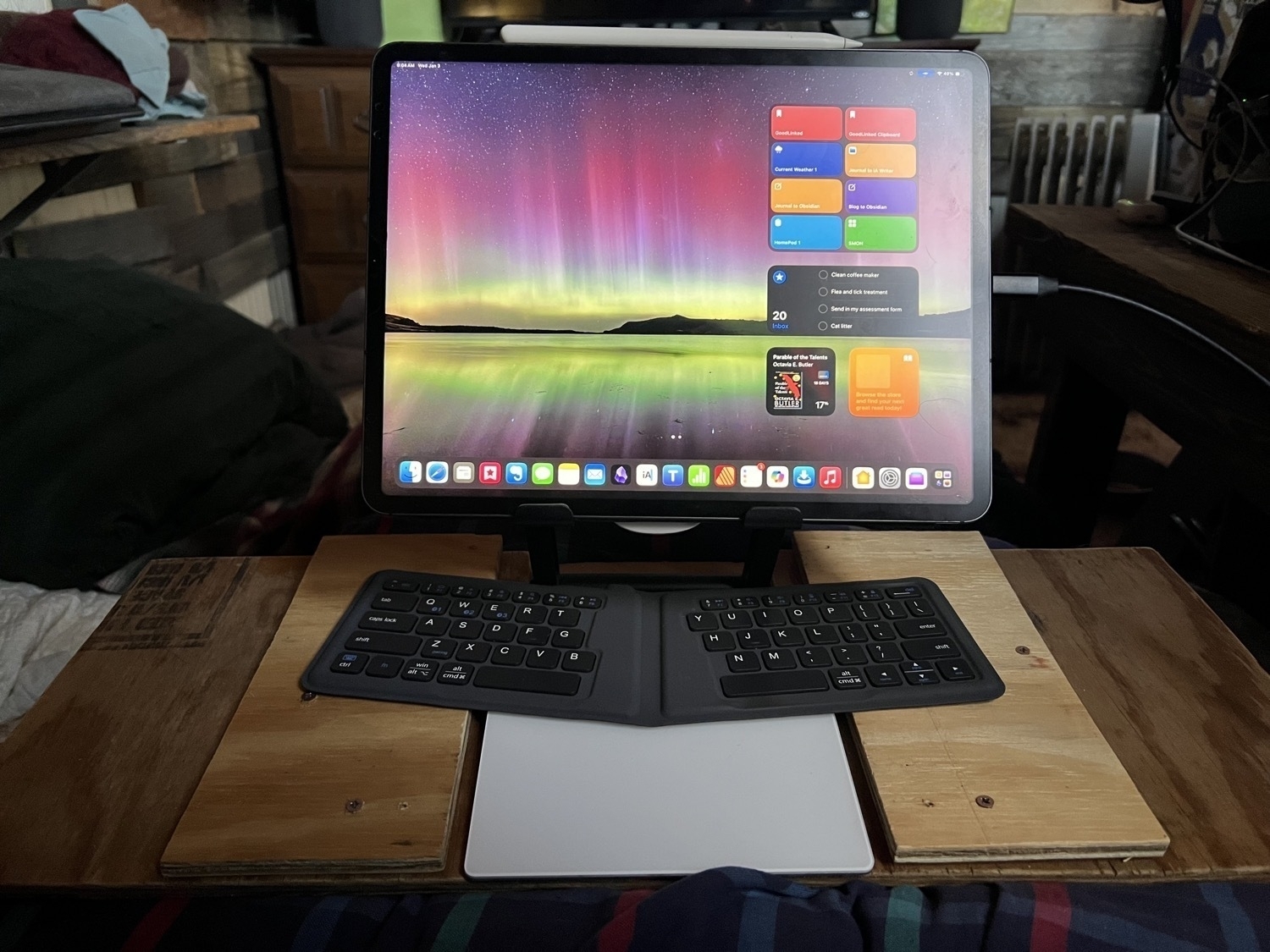
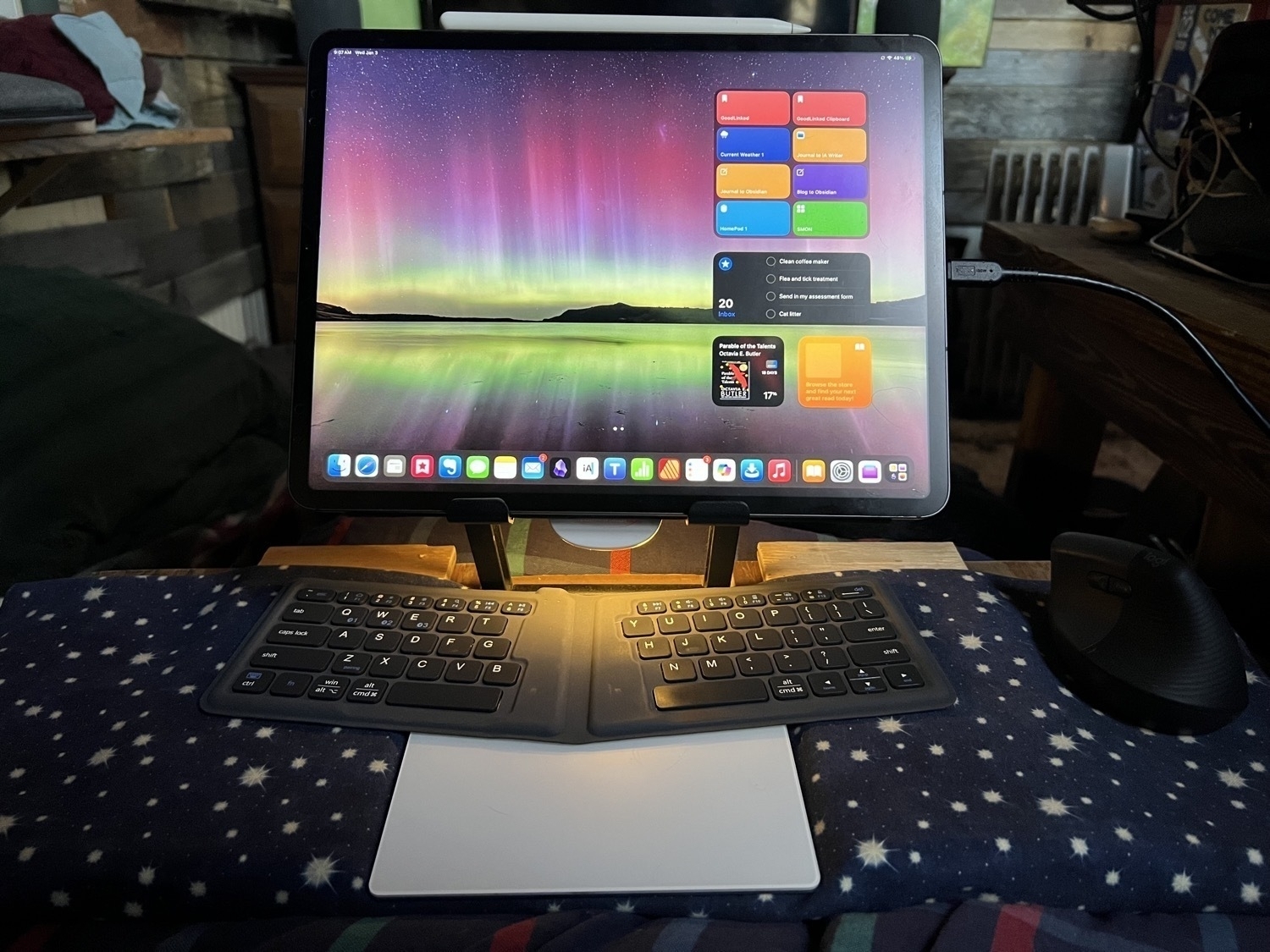
Over the past year I’ve enjoyed my various and ongoing configuration experiments. Just yesterday I modified my lap stand so that I can easily center my trackpad below the keyboard. By adding two small sideboards it’s now a recessed trackpad. Works perfectly and there’s plenty of room for the mouse to the side. In use I keep a pillow case on top for comfort.
Between this stand arrangement and having the adjustable shelf-clamped stand I have a variety of choices. A side benefit of this regular experimentation is that my set-up is fun and never feels stagnant.
My iPad Mini 5 and iPhone 13 both continue to work well and I expect to get at least another 3 to 5 years from both. The responsible thing is to use all of this hardware as long as I'm able and that's the plan. I want to appreciate not just the resources each device embodies but also to appreciate a kind of connection that comes with using a tool for a while. I expect I'll be able to get another year from my Appe Watch 4.
Among tech enthusiasts it seems fairly common these days to trade up to the latest, greatest fairly often. And so these valuable, powerful computers are being treated like disposable goods. Really, it's something that only a minority of the wealthiest and most privileged of humans can do and it's irresponsible. But also, it doesn't allow much room for the nostalgia that comes with long-term use. My 9+ years old iPad Air 2 still works and is put to use to run the DarkNoise app and occasionally for photo slide shows.
All that to say that I've been very happy with the over-abundance of computer/tech hardware that I have.
Image of one corner of the interior of my tiny house, 2024-01-03.
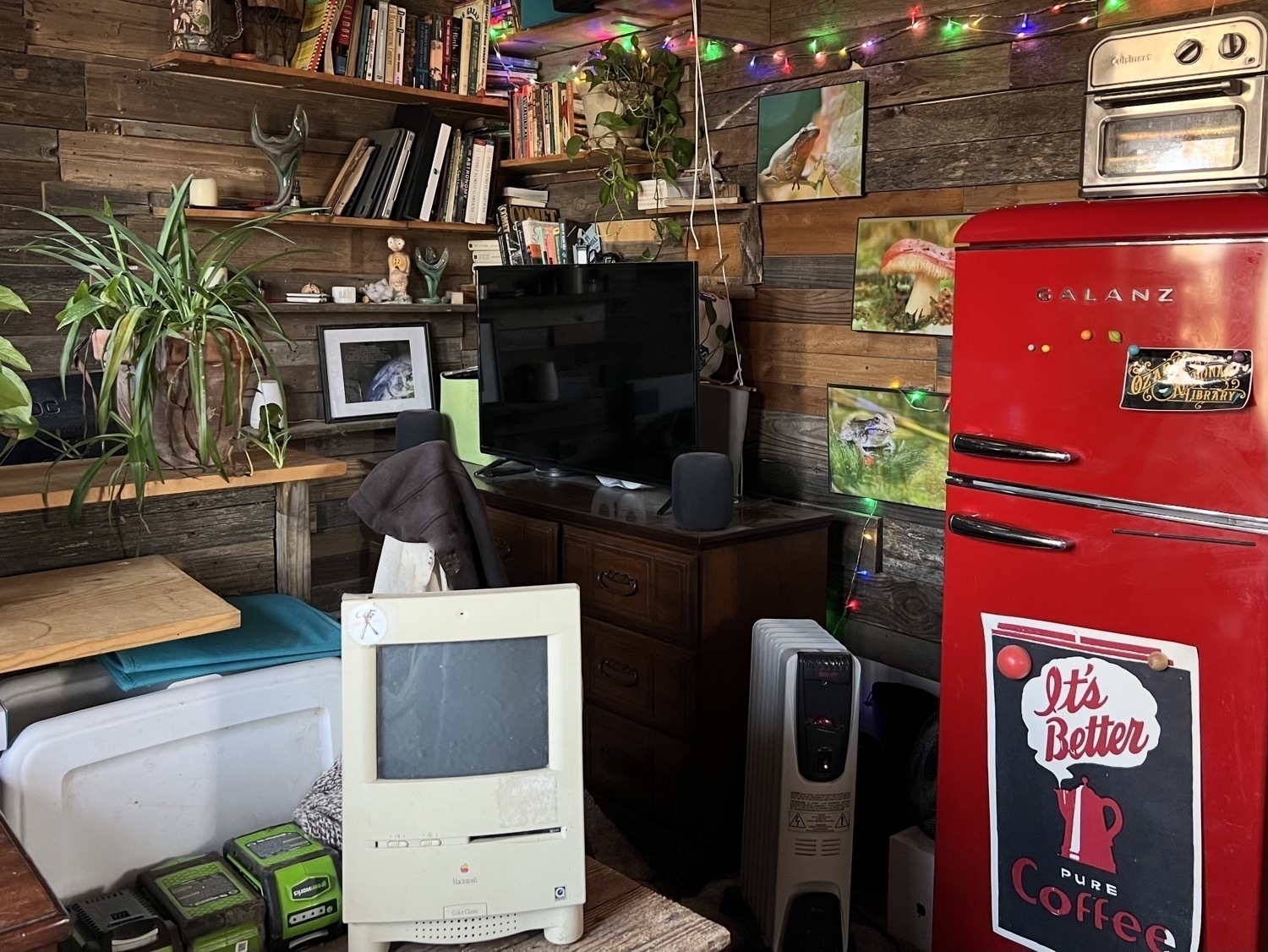
Over at Mastodon Jason shared this article about living a simple life. The post offers up some helpful, worthwhile suggestions about being more thoughtful in life choices in terms of the usual practice of keeping up appearances, consumption-based living, etc.
I looked at a few other posts from the site which offered similar good advice. But it is the packaging of minimalism and simple living that has become a bit of a meme on the internet. And while such sites might serve as an introduction to questioning consumerism as a way of life they often have something to sell. I wasn’t too surprised to see that, indeed, these folks offer a paid course. Even the simple life has a price. 😉
But yes, it’s increasingly obvious that our modern way of life is putting strains on our mental and physical health as well as on the ecosystems of the planet. In the developed nations the top 10% have built a way of life based on hyper consumption of resources which requires constant work and a focus on income. For many the vision of the “American Dream” is playing out as something else entirely.
We’re living in a time of persistent crises. The climate crisis serves as the background and it alone represents an existential crisis. But on top of that there are many others that surface as a result of the world we’ve built. The “simple life” and “minimalism” offer up a glimpse of something else. They hint at a calmer, quieter life with reoriented values like time spent or experiences a relationships rather than stuff. On the surface this sounds good because want to feel better, we want relief from the crises of modern life.
But let’s not just go for relief. Too often our drive is our physical and/or mental comfort and often that means a quick fix or band aid. So, let’s not just stop at the notion that our problem is too much stuff. Yes, acquisition of too much stuff is a problem but really, it’s also a symptom of a deeper cultural problem.
Let’s dig deeper.
Capitalism is the basis of modern, western nations. For decades it’s been sold as congruent with democracy, almost as though it is the other half of democratic society. It’s been assumed by many to be normal, natural and the way that economy should function. Certainly this is the commonly held view in the United States. But at the base of capitalism is insecurity, the never ending drive for increased profit through increased growth and consumption. These are fundamental, foundational to the “American Dream”.
The problem with simple living and minimalism as commonly discussed is that they serve is a temporary balm but leave us with problems. And so we just continue in long crisis. We experience it personally as perpetual longing for the unknown thing that we think will help us feel more secure, happier, content. It’s always there over the horizon. It’s to be found in documents like the US Declaration of Independence: “Life, liberty and the pursuit of happiness.”
Happiness. Dare I say that perhaps a part of our problem is our focus on our happiness? It seems normal enough, to want to be happy and to search for what makes us happy. But happiness is ephemeral. It’s not a permanent state. And we live in a time and culture when it’s a fairly common message that what brings us happiness is the purchase of that next thing. Or, even, that next new experience. It might be a concert, movie or a trip. But no matter what we consume, the “happiness” is fleeting and within hours or days, we’re onto the next thing we want.
My suggestion is that we consider shifting our focus away from our pursuit of happiness. And don’t get me wrong, it’s okay to be happy, to experience joy. But I would suggest that we need to go deeper in our search. That it would be more helpful and meaningful to ask other questions. To begin, what is our purpose as humans. How can we contribute to the well being of not just our families but our communities? Will our life on the planet leave a it degraded or even severely degraded to the degree that future life will suffer?
I’m not going to claim to know all of the questions we should be asking or to have the answers. But, rather, that we should be asking more of ourselves than we have been.
I’d like this to be a series of posts because it’s the kind of exploration that can and should branch off into side explorations. For example, what is the result of a culture that encourages a focus on the nuclear family as many of the wealthy nations do?
Thinking living simply, there are practical considerations of how we think of exercise and physical labor in a time when many work in offices. Which is a subject can then branch off into the tools we use and how they may be measured in terms of longevity, repairability, carbon footprint, and requirements for use.
There’s a lot to explore and I’m planning follow-ups.
Manufacturing new computer hardware requires lots of energy and resources, not to mention the creation of undesirable byproducts. The production of one of the most vital components of computers, microchips, is especially resource-intensive. As a result, according to permacomputing principles, they should be treated as precious resources — because they are — and their lifespans maximized. They would not be reduced back to raw materials until absolutely necessary.
Hmmmm. Day two with Day One 😉
My habit is to use text editors primarily for blogging. So, now I’m thinking about how to use Day One. Probably over thinking it. I’m aware that most of my time writing is about sharing, usually via blog. This app seems geared towards private journaling for the sake of recording life moments. Right off I’m trying to bend it to blogging. And still considering whether or not I could do something like this in Notes.
It’s far too easy to get stuck in a game of app hopping. Comparing Day One to Apple Notes and I like the Day One sidebar. The grouping by day is helpful. I can edit the dates if needed. The app includes weather and other metadata that would be a nice-to-have info when looking back.
BUT, unlike Notes, I can’t view across devices. I’m not used to and don’t like the navigation via the arrow keys. I’m used to using arrow keys for moving the cursor in the text. This seems like a weird choice and there’s no setting to change it. Ugh.
Okay, so, I spent the last 30 minutes in Notes. 🤣 If I had a nickel for every time I’ve played this game. But listen Linda, Linda, Honey, I think I’ve got something. I think perhaps I can make Notes work in more ways than one…
To be continued as follow-up post on my blog at Beardy Guy Creative.
20 years of blogging
Well, it's 2023 and we've seen a nice resurgence of blogging and a new emphasis on the decentralized web in recent months. From Mastodon to micro.blog and many others, it's exciting to see so much energy. Along with all of this new energy, I've seen quite a few posts from folks who have been blogging through these past couple of decades, often reminiscing and celebrating the return to the decentralized, self-published web.
In one such post a couple of months ago, someone mentioned they had been blogging for 20 years. It occurred to me that was probably true for me as well so I visited the Wayback Machine to see if I might find my old blog. An interesting trip down memory lane seeing that old bit of my personal internet history! My first blog dates back to March 2003.
Previous to that blog I had set up my first website in 1997. Liberated Existence was not technically a blog but I posted weekly updates to a news section. Some were updates about our various local projects, others were news happenings of interest to leftist activists. The main site included a little network of sub-sites that served different purposes and projects. A sampling of our various projects included a micro-radio station, Food Not Bombs, and a Memphis branch of the IWW. Most days from 1997 to 2003 included some sort of update to Liberated Existence or one of the sub-sites.
I have so many fond memories of time spent learning html and then css. From the technical aspects of building and maintaining a website to the excitement of publishing online. As an activist who had been publishing zines, newsletters and several small community newspaper projects along side of a micro radio station that was shut down twice, the potential of the early, decentralized internet was inspiring. It felt like we were building something together. I'm glad to see the excitement again.
This time around I'm hoping that there is a new awareness of what happens when people give up control of their publishing to corporations. We've got 15+ years of Facebook and Twitter as an example of what not to do going forward. We can't know where this new-old path will lead but it seems better. And I hope we'll protect it better than we did before.
I started writing yet another post about iPad and the Apple pundits' hot takes. That post has now turned into two posts one of which is comparing today’s Apple-oriented online culture to the late 90s and early 2000’s. And now a third post writing about the other two posts. 🤣🤓
A couple months ago I decided to try out a couple of iPad accessories from Moft. They have a series of products that are designed to work well together, the Snap System. I bought the Snap Case and the Snap Float Stand. The various items can be purchased separately or in bundles. Their website is a little confusing when trying to create bundles.
Of the various iPad accessories I’ve tried over the years I think this pair is my favorite. While I spend some time at a desk I’m often on a futon/beanbag and this combination works great in both places. In both situations it works well to be propped up at various angles in the horizontal or portrait positions. The float stand is also a kickstand that can be used in so many different orientations that it is basically without limit. And it’s very stable on a pillow in my lap.
Fairly typical configurations over the course of a day:

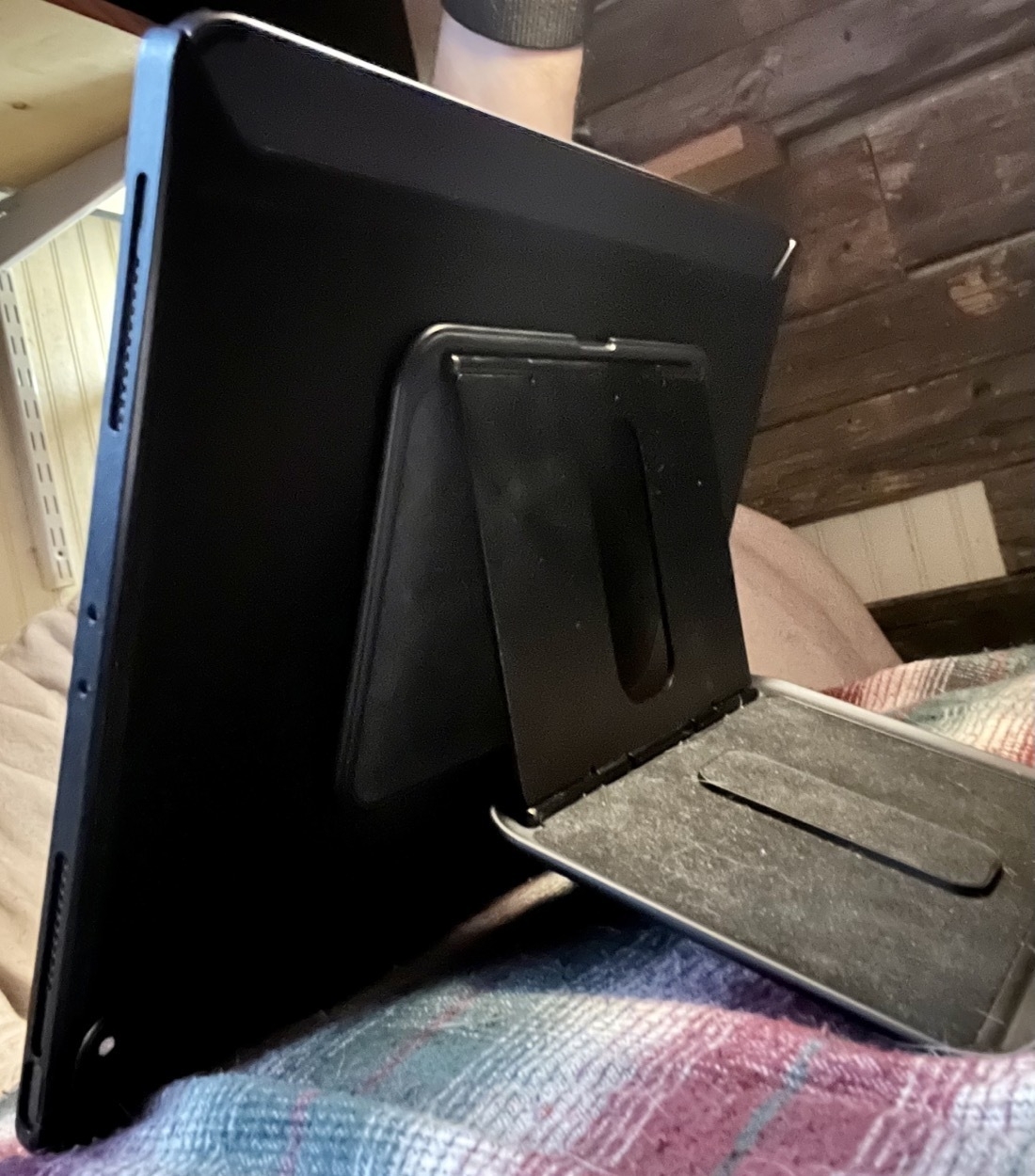 iPad propped up in horizontal position, Pencil attached at bottom
iPad propped up in horizontal position, Pencil attached at bottom
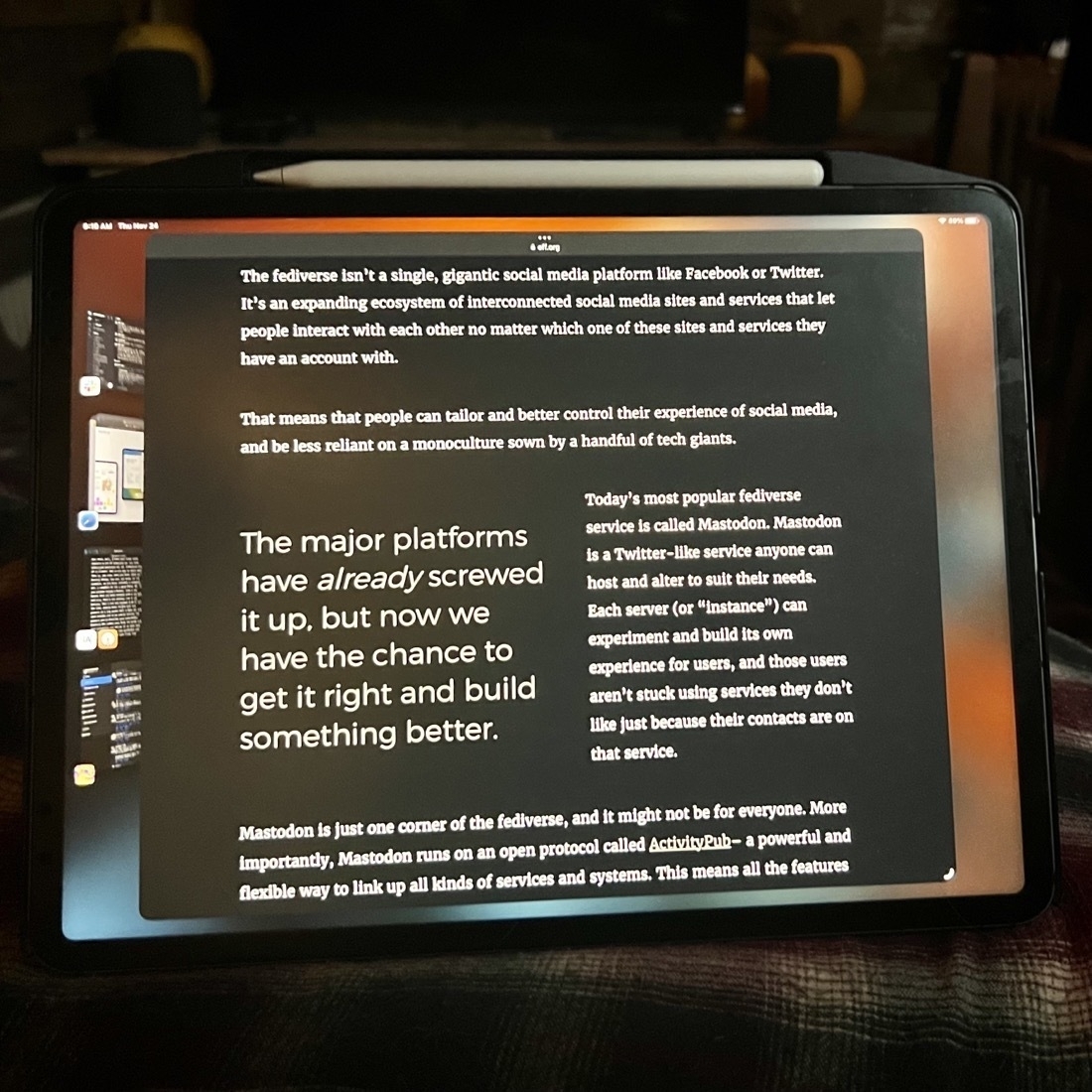
 iPad propped up in horizontal position, Pencil attached at top
iPad propped up in horizontal position, Pencil attached at top

 iPad propped up in portrait mode
iPad propped up in portrait mode
I find that with this case and stand I’ve been using the iPad as a tablet far more because I like having it propped up but without a keyboard in the way. If I want a keyboard I can just reach over and grab it. If I want a keyboard/trackpad I can attach it to the Magic Keyboard which is also nearby.
Because the stand and case are magnetic the stand pulls away easily. I did find that the embedded magnets in the Snap Case were not as strong as I wanted them and I was getting accidental detachments when readjusting the stand angles. Moft includes an extra sticky metal plate with the stand so I attached that to the case as it provides a much stronger connection that never comes off accidentally.
The Snap Case is really thin and Apple’s Magic Keyboard attaches just fine to the Snap Case and closes too though it bulges a bit with the added thickness. That said, because the case is so thin it’s not going to provide much protection in a fall though it does provide a bit protection in terms of daily wear along the edges and back-side.
Two last notes. First, the case also has a convenient spot for the Pencil. If you have a Pencil and like keeping it close by this is a nice addition. It also serves as an extra place to hold the iPad. Second, while the case provides access to the 3 buttons on the outer edges of the iPad it makes it fairly difficult to actually press those buttons.
#iPad
But wait, according to all the Twitter/YouTube/podcast Tech Bros, the iPad is broken and barely usable. Someone please tell her that what she’s doing isn’t possible. 😉
iPadOS 16 new features tips for iPad note taking, digital planning, journaling & more - YouTube
Interesting news in my local town, a new cobalt and nickel processing facility for lithium-ion batteries. Fredericktown’s history is largely based upon lead mining in the 1800s. Mine LaMotte was the beginning of that. The area also has rich deposits of cobalt and other elements. So they’ll be doing both mining and processing.
Mixed feelings. On the one hand, this will, no doubt, be a new source of local pollution. They claim that the goal is “to supply clean, domestic and ethically sourced battery metals, free from child labour and human rights abuses that it sees as currently plaguing the cobalt supply chain.” But, you know, the reality will be that there will be toxic by-products.
That said, I have an iPhone and numerous devices that use these batteries. We really should be sourcing materials locally when possible. It’s irresponsible and unethical to turn to other countries for materials for devices we’ll be using if those materials are available here. The facility is about 5 miles from my place and is surrounded by various farms. Will be interesting to see how it develops.
Missouri Cobalt close to finishing key facility for cobalt, nickel production
A lot has been said in recent days and weeks about iPadOS 16 Stage Manager currently being used by beta testers. Some folks are finding it very buggy or just having difficulty with the design of the new feature. It’s far from perfect, no doubt about that. I’ve been bouncing back-and-forth between using the feature and then turning it off to go back to the default split screen multitasking. There’s much to like about Stage Manager and for the most part I’m enjoying it. If not for the buggy resprings I would likely leave it on.
I found that for myself, it seems to work best with the dock, turned off, and the side multitasking strip also turned off. Even the larger 13 inch iPad is still a relatively small screen so by turning those off I’m getting a bit more room for window content. I think the greatest potential for this new feature is probably with the 13 inch screens or something larger that might come in the future. Also it’s great on an external monitor which I use a couple hours a day.
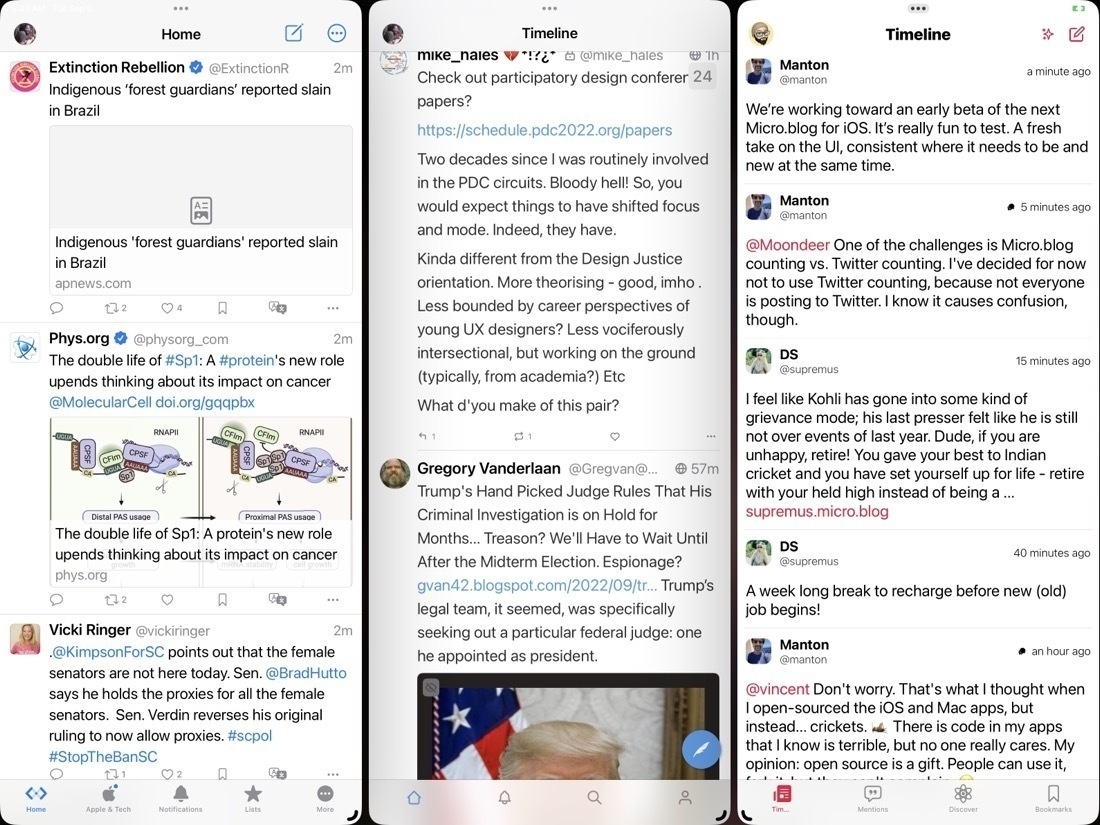
My favorite use thus far is 3 windows side by side taking up the full screen. Two groupings in particular: Spring for Twitter, Twidere X open to Mastodon, and Gluon for Micro.blog. Another 3 windows set-up is Mail, Slack and Messages. In general I like the width of 3 windows side-by side on the 13" iPad Pro.
What would I like to see changed? Like many have commented on, when changing window sizes pre-determined window sizes are chosen for the user rather than fluid free form window sizing, and that can get to be a bit tiresome instead of being helpful. In my use it requires me to do more work than I should have to rather than less. Personally my preference would be to have free form window sizing but with a grid like snap to feature  similar to that found on  Windows. I would imagine half screen, quarter screen, and 1/3 screen, those sorts of size options. There are similar third-party apps available for the Mac that seem to be popular.
Also, when switching apps sometimes things can get a bit confusing, especially when using an external display.
Rural Cycling and Micromobility
My Journey to the e-bike
I’m a child of the suburbs. I grew up thinking that the bicycle was a toy rather than actual transportation. In Arnold Missouri cycling anywhere outside of our “subdivision” just wasn’t something anyone did. Though our neighborhood was only three miles from “town”, they were narrow. I don’t remember ever seeing a cyclist on the particular road that one would have taken to Arnold from our location.
When I went off to college in Kirksville I got my first taste of using a bicycle for transportation. Beginning in my third year I lived off campus and got an old Schwinn which I equipped with a pair of inexpensive metal baskets. I used it for riding a half mile to campus, a quarter mile to the laundromat, and a mile or so to the grocery store. That was the beginning of my love of the bicycle and my understanding of it as an inexpensive, efficient form of transport for humans. As a small college town, Kirksville had a diameter of maybe 5 miles and was surrounded by farms. As transport, a bicycle was almost the perfect form of transport on the small side streets that made up most of the town. For myself and many others in the town, the bicycle was all the transport we needed and at very low cost of ownership.
When I moved to Memphis that bike went with me and got regular use there too until it was stolen. I replaced it with my first mountain bike. My transport was a mix of walking, cycling and driving depending on the task, destination and distance. But without a doubt cycling and walking were my preferred and predominant forms of getting around. Cycling was my practical way of transport but also grew into something new as I realized it’s benefit to my personal health as well as the environmental and community benefits. I began riding for pleasure, and my 15 miles a week for transport turned into 100 miles a week for fun and transport. This was the case until a knee injury forced me off the bike in 2001.
I reluctantly went back to walking and tried my hand at using one of the very first electric scooters on the market. It was functional but was not a great experience. Instead of feeling in control of my body and vehicle as I cruised along at 15 mph I was suddenly not in control and moving something closer to 10mph. I could not easily maneuver from street to sidewalk and always felt a little less safe. Even worse, the scooter was limited to 3 to 4 miles per charge. It was usually just barely enough to get me to work. I used it for a year or so and then went back to a mix of walking and, reluctantly, driving. At 32 years old I was fairly healthy but generally resorted to a car for transport to work because of the knee injury was enough to keep me from cycling.
Then I left Memphis in 2004 and stayed with family for 4 years before settling into my tiny house at my current location which is about 6 miles from the outer boundary of the nearest town, Fredericktown. And while I’ve gotten in plenty of recreational walking over the past 15 years, I’ve relied on a car for all necessary transportation into town for shopping or any other required errands. Due to my concern about climate change I’ve limited my car trips to town to an average of about 6 trips per month which works out to 90 miles drive per month given a round-trip distance of 15 miles.
Over the years I’ve kept an eye on small electric vehicles, especially e-bikes. In the past couple of years the technology has been making some big gains. Batteries, motors, conversion kits, and fully assembled bikes are all becoming more readily available at lower prices. Probably the most important advancement has been improvements to the lithium-ion battery. In any case, I wasn’t sure that I’d have a use for one because of my rural location but this past summer my interest in the possibility began to take hold. In late summer I discovered a new electric bike by Lectric that fit with something I could afford and which might have the range I need to be useful. A week ago I ordered it. It is scheduled to arrive today.
How will this be useful in my rural location? I’ll admit, that a part of my reasoning for ordering the bike is simply to enjoy the pleasure of being back on a bike. Initially I expected that, at a minimum, it would be useful for visiting my parents who live a mile away. I regularly walk that distance with my dogs for their exercise and to get mail so in that regard, I typically cover that distance on foot so it would not be essential except for making the trip faster, more convenient and more frequent. More frequent and convenient trips to visit my parents was the other motivator. But then I started looking more closely at other possibilities for extended range use.
Rural transport by e-bike?
Like many others in rural areas, I have roads that would be fairly dangerous to use for cycling. The primary 2-lane road between my tiny house and town has a 55 mph speed limit and no shoulder. I’d never feel safe cycling on it. But there is another route, a county road which is only an additional half mile. Much of this road is paved, a large stretch of it is still gravel, but it will get me to the outer edge of town at about 6.7 miles. The ride to the grocery store is 8 miles, a round trip of 16 miles. This road has far less traffic than the 2 lane highway and should be very safe for cycling. It will bring me all the way to the safety Fredericktown which largely consists of low traffic side roads that have speed limits of 25 or less.
The e-bike I’ve ordered has a cruising speed of 20 and a range of 25 to 50 miles which varies with rider weight, terrain and the amount of pedaling the rider contributes. In short, it will easily handle the 16 miles I need with a good bit left over. I should have no problem with light-weight, low stress pedaling. Not only will this get me to the grocery store in about 25 minutes but also the library and all the main street shops if I need them. Also, Fredericktown has two, two, ice cream shops.
In other words, a $1,000 e-bike will make it possible for me to reduce my car-based trips to town to one a month rather than four. And if I were in a position where I needed to daily commute to town for work I could do that with this bike. In considering this for myself I’ve also pondered the possible usefulness for this kind of device in the larger rural community, hence the title of the post. Is micromobility useful in a rural setting? Before I attempt an answer, perhaps some context would be useful. From Micromobility.io:
The mobility world we know today is based on 100 years of technological development. From the Internal Combustion Engine enabled by Rockefeller’s refined Standard Oil to Ford’s innovative supply chain that allowed Model T’s to come off factory lines as easily as bottles of soda. From the mandates of President Eisenhower putting WWII US veterans to work building the most massive network of roads the world had ever seen to the rise of suburbia, malls and edge cities, a car in every driveway came to symbolize the American Dream.But that car is a bundle. As a pre-paid option to go anywhere and at anytime, a car offers a bundle of trips whether short or long and whether used or not in a box weighing, on average, 20 times its payload. The externalities of this arrangement are becoming daunting. From more than 1 million fatalities every year, to climate change, to congestion that saps productivity and enrages, this object, carrying typically only one passenger, ceased being a liberator. The bundle became overbearing and over-serving crushing more value than it creates.
Where do we need to go?
An excerpt from the Micromobility Manifesto:
Micromobility is a big word for a small idea.The idea is small in the sense that it represents machines that are small.
Machines that are sized to the job at hand: moving people. And not sized to the process that makes them move.
Machines made to fit us not their internal violent reactions.
That such machines are now possible is a testament to our inventiveness and we consider that inventiveness as our superpower.
This manifesto is a call to use our superpower to make moving better.
Better by getting there happier, healthier and more in harmony.
In harmony with our environment and with each other.
In the medium to long term, it’s not really an option. If we’re going to address the problem of climate change we’ll need a radically different system for moving people and goods. But, again, can e-bikes, be useful in rural areas? For some in rural areas, yes, absolutely. Right now it is possible given current roads. In my use-case, the e-bike I have coming will work perfectly for my location. Looking at a map of the area around Fredericktown tells me there there are many other people living close enough to Fredericktown with direct access to the same kind of lower speed, low traffic county roads that they also would likely be able to meet at least some of their transport needs in the same way.
But there are many who, just a few miles away, would not be able to safely ride to town due to the higher speed, higher traffic roads they are limited to. But the variables change over time and what might be unsafe now might be safe in 5 or 10 years. The changes might come culturally, technologically or in terms of infrastructure. Let me provide an example.
In the past three years our county has become home to a Mennonite community. Within this short time period the local 2 lane highway that I will not use for cycling has become a primary route for Mennonites using their traditional horse drawn wagons. Now people expect to see them on the road and it likely has an impact on the perception of what normal traffic is on this road. Just three years ago the expectation was that this road was only for cars driving at 50 mph.
The point here as that what a community considers to be traffic changes. Our community now expects and accepts horse drawn wagons in and around town. We are prepared to slow down for them on the 2-lane highway and drive around them safely as we are able just as we do for farmers on tractors.
Similarly, as other forms of vehicles, in this case, e-bikes, come into wider use, their presence will change what is perceived to be acceptable and normal traffic. Of course, it’s not the same as a person on an e-bike is much smaller and in some ways more vulnerable. Even more, e-bikes (and bikes generally) are not very common on the roads in this area.
But what would happen if the bicycle grew in popularity over the next decade? Given the poverty of this area, affordable, sub $1000 e-bikes would be a great benefit for many in town and in the surrounding rural countryside. A recent report looking at e-bike trends forecasts a remarkable jump in production based on current growth trends. From the millions we’ve seen per year in recent years the trend points to 130 million e-bikes in global production between 2020 and 2023. The Verge reports:
The next decade is going to be defined by a revolution of battery-powered transportation, and the vehicle that will lead the charge won’t be the Tesla Model 3 or even the wildly polarizing Cybertruck. And it definitely won’t be an electric scooter.It will be an electric bike.
Of course most of these will be sold in urban areas that are often viewed as the ideal place for bicycling and the e-bike due to the close proximity of destinations. In an urban setting 10 miles or less will get one to anything they need.
What I suggest here is that rural areas are actually somewhat similar even though on the surface that might not be the case. At a glance rural areas are spread out. But again, many rural residents depend on towns within 10 miles of their residence and with access to low traffic, low speed roads similar to the county roads I’ll be using, they could likely reduce their use of automobiles by substituting modern and affordable e-bikes.
All that said I’ll end on a note about American culture that seems to be especially true of rural culture that generally is more conservative. Cars are sacred, cars rule, and in the countryside trucks rule. No matter how irrational combustion-based travel may be it is a solidly entrenched norm here. For most it is a part of their identity and how they define themselves. As I recently searched through YouTube reviews of my purchase I came across two reviews by farm families with YouTube channels. Both initially laughed at the idea of trying an e-bike. Men on farms use big tools, loud and smelling of gas! The idea of such a quiet form of transport was an affront to them. Too vulnerable, too weak. But then they and their family got on the bikes and the unexpected happened: They. Had. Fun.
The e-bikes of 2019 are not weakly powered bikes. Turn the throttle and you zoom off. They are fast enough to be scary at first and then they settle into fun once the rider is used to them. And some of them can be put to real work, even on a farm. Put a crate on an e-bike and you can carry up to 50lbs on the back which easily accommodates a chainsaw and some tools. And I’m just talking about the more popular e-bikes that are designed for general commuting. There are others that are heavier duty cargo bikes and more will come.
The e-bikes of today and tomorrow have far more power and range than people realize. The are fun to ride and quite capable of transporting a person as well as tools and goods. But at the moment they are an unknown. I suspect that as people interact with them and see them more often they will grow quickly in popularity. They are inexpensive when compared to the ownership of a traditional automobile and make a lot of sense as real transport. And in the small towns that dot the rural landscape riding an e-bike should generally be as safe or safer than riding in an urban setting.
So, to answer the question, can micromobility become a part of small towns and the surrounding rural areas? Absolutely.
Links of interest:
Webiversary
I came across a post the other day talking about the early web and it got me thinking a bit about my time on the internet and specifically the web. My very first experiences, pre-web, were with email via service called EcoNet back in 1993ish. As I recall the service was a sort of basic internet that offered a text-based access and email. The service was provided by the Institute for Global Communications:
In the early '80s people from four San Francisco Bay Area non-profits (ARC Foundation, Center for Innovative Diplomacy, Community Data Processing, and Foundation for the Arts of Peace) came together around a vision of a computer network to support the work of individuals and organizations working to reduce the risks of war and to promote peace. As a result of that collaboration, PeaceNet was launched. Another early online network, EcoNet, joined with PeaceNet and the project became the Institute for Global Communications (IGC).
[caption id=“attachment_1489” align=“alignnone” width=“2608”]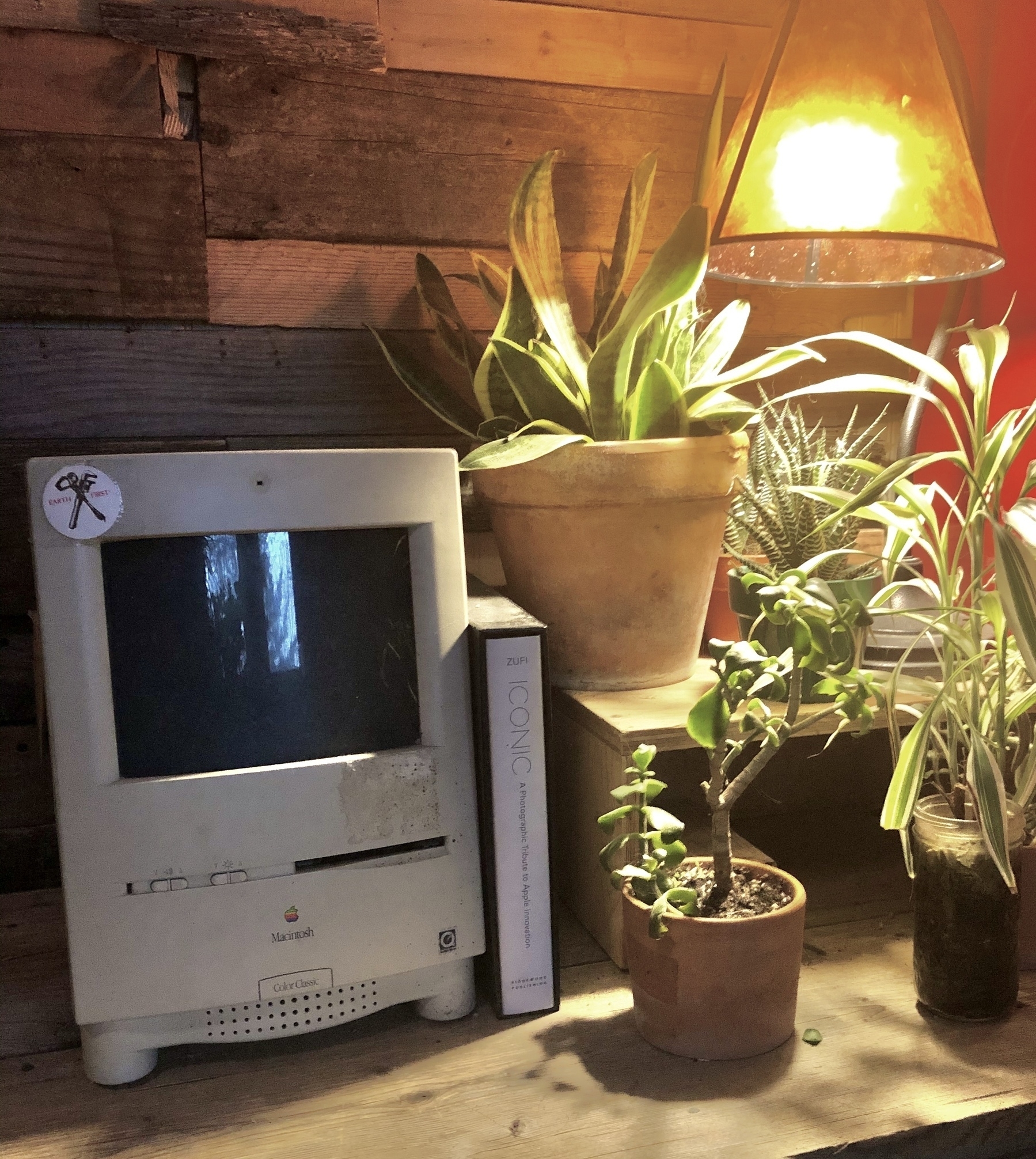 Murray, my old friend![/caption]
Murray, my old friend![/caption]
I used My first Mac, a Color Classic with that service for a couple years then dropped off for a couple years. In 1997 I was working with various community groups in Memphis and we wanted to set-up a website. I guess that at the time I was the nerdiest of the bunch and volunteered. I quickly discovered that my beloved Color Classic was not up to the task of running the early version of, Netscape Navigator. I went shopping and purchased my second Mac, a Performa 6400.
It was with this Mac that I wrote and coded my first website, Liberated Existence.. A static website that I updated almost daily. It quickly grew from a single home page to a series of pages for the various projects our group was creating. The first crawl by the Internet Wayback Machine was August 2000 but the site had been in existence since 1998. Of the various things I’ve done in my adult life publishing a website on the web is probably the one which I have engaged in most consistently.
I coded the site by hand initially, using a text editor, BBEdit and uploaded via an ftp app, Fetch. That was it for the first couple years. At some point I started dabbling in a variety of web creation tools ranging from Claris Homepage to Adobe GoLive and Macromedia Dreamweaver. This was the beginning of my continuing life-on-the-web.
My first “blog” was built on Blosxom which is still a thing apparently. At some point I bounced over to Typepad.com and then to Blogger at some point. During that time I changed the name of the blog several times. I believe the first iteration was the transition of the static Liberated Existence site to a Blosxom blog and at some point I used the name Where We’re Bound. At some point around 2008 I renamed the blog “Our Tomorrow” which I kept until 2015. Both of those titles were meant to evoke thoughts of the future. In the case of the first title, I thought Where We’re Bound had a nice double meaning. Where are we headed but also, in what ways are we bound or tied up from free activity. In what ways are we humans incapable of dealing with our present and our future. I think the follow-up title was a good choice as humans in the first two decades of this century are making crucial choices which seem to be limiting our future survival on the planet.
I expect the current title, Beardy Star Stuff will stick around until I’m done on the internet. The archive contains all previous versions of the above mentioned blog titles and goes back to April 6, 2003, a post titled God Talk.. I’m fairly certain there were some posts previous to that but they seem to have been lost at some point during one of the above mentioned transitions. Oh well.
So, yeah, it’s been 21 years now that I’ve been building my tiny little corner of the web. None of my sites have ever been heavily trafficked and I’m okay with that. I did them as much for myself as anyone else. I suspect I’ll continue in my haphazard web-building practices for a good while. At this point it’s a practice that probably leans more towards habit than the passion it was 20 years ago. But I still enjoy it so I’ll keep at it.
Note, I’ve only spoken here of my personal creations. I’ve also been busy building websites for clients since about 2005 but really, that’s another story for another time. Perhaps it’s something I’ll reflect on at my other tech-oriented blog at Beardy Guy Creative.
Introducing the iPad Journal
As is often mentioned in the Apple-centric media that Apple does not do enough to promote the iPad. Specifically that Apple fails to tell the story of what people can do, are doing with the device. I've certainly become a bit obsessed with the iPad in the past few months. I've had one since the first day they were available to order but it took six years before it really clicked for me at which time I went from a consistent casual user to nearly full time user. In 25 years of using Apple tech I can say that this is my favorite device thus far and the one I'm most likely to be using at any given moment.
So, I'm planning an ongoing journal of sorts in which I'll share not just how I'm using the device day-to-day. I'd like to get into the tasks the device helps me tackle and the apps I find most useful in
the process. I want to tell the story of how and why the iPad has become my favorite and most used technology. Lots of others are doing the same thing and I intend to link to what they are doing as well.
For example, writer Matt Gemmell has recently gone "iPad only" and has written a fantastic series on the process. I highly recommend it. I follow Matt on Twitter as well and I really appreciate his take on things. I'll be sharing bits of what he's doing as he's got a great way of delving into specific areas and workflows that I find helpful.
Others are Federico Viticci and Fraser Speirs who have been hosting the Canvas Podcast which is all about being productive on iPad. Federico is well known as an iPad advocate and is the publisher of MacStories. He writes a pretty amazing review of each year's iOS update and is one of my favorites.
Then there is Serenity Caldwell, Rene Ritchie and iMore in general. Serenity or Rene use the full range of Apple tech but both use the iPad a lot and often write about it, especially Serenity. I've come to really appreciate iMore as a site that that tends to stay positive and one which increasingly focuses on how to use Apple tech rather than share rumors.
Most recently I've really enjoyed the writings of Matt Birchler at BirchTree. He uses an iPad Air 2 as his main machine. I expect I'll likely share some of his posts as well.
There are plenty of others.
Oh iPad, not again
As has become routine when Apple announces it's quarterly financials the Apple pundits have much to say about the iPad which has seen yet another decline in numbers. Most of it mirrors what has been said the past couple of years which is to say concern that Apple is not doing enough to develop the iPad part of iOS and also that not enough is being done by Apple to promote the iPad. I agree with both.
A lot has been written this week on the topic but the two I found the most useful were by Rene Ritchie and Khoi Vinh.
Rene's post was notable in that he hit on something that has really been bugging me, that the Apple-centric media has gotten into the bad habit of mostly writing for itself and analyzing Apple only from it's very narrow perspective. The problem with that is that it results in a very distorted and, frankly, wrong analysis. The general public thinks and behaves very differently. A part of why the Applesphere has gotten the iPad story wrong is because they have forgotten that the mainstream does not obsess about this stuff. They don't obsess over the details of the operating system nor do they update their computers every year or even every other year. It's a fun device with practical uses. There are at least 16 of them being used in my extended family but they don't get updated every other year. There are original iPads still in use as well as all the other versions. They are sturdy devices that are being used for multiple years before being replaced. As Rene pointed out:
That's what Steve Jobs meant when he called iPad the future of computing. His dream, and the consistent goal of Apple over the years, from Apple II to Mac to iMac to iPad, was mainstreaming computer technology. It's also why Jobs spoke of trucks and cars. iPad wasn't a PC, it was something that the majority of people would eventually find more practical than a full-on PC.
It seems pretty clear that at least a part of the reason that iPad sales have declined is that many were purchased over the first 3-4 years and those are still being used and many will continue to be used. An iPad 4 is good enough for my sister, my parents, my granny, my aunt, my uncle and so on. They very likely don't even know what version of iPad they have or what version of iOS it is running. Until it runs out of storage space they'll keep using it.
In his post The iPad Is Not Done, Khoi Vinh, says a bit more about the iPad as it relates to those of us that do more with the iPad than non-techies. Specifically that the iPad has much more potential with the refinement of iOS. This is a group of people that have spent more time thinking about the iPad as a tool and would like to do more but have found it lacking thus far or found it lacking three years ago.
However, I don’t find it plausible to conclude that just because the iPad isn’t growing right now that that means it can’t grow again. For me, it’s a fallacy to think that the iPad we have today represents the peak expression of what an iPad can be. Yes, you could argue that the trend towards larger smartphones and thinner laptops has robbed the iPad of some of its distinctive qualities, but that would really only be true from a hardware perspective. There’s loads of untapped potential in iPad software.
I think this group includes people that complain about the iPad not having this or that feature when in fact it does. People that may have tried it in the past and written it off fairly quickly. These are folks that take their computing seriously but want the power of an operating system they are used to. From 2011 to 2014 iOS was far more limited on the iPad. I suspect that many from this group have not given iPad a proper re-evaluation and may not have explored all of the features introduced with iOS 9. They still see the iPad as the device that was unveiled by Steve Jobs in 2010. They've long since given their iPads to their kids to use or have lost them on a shelf somewhere. They likely use a Mac and an iPhone.
This group also includes the people who are actively using an up-to-date iOS 10 iPad and are fully aware of the features and the shortcomings. This group sees the potential Vinh wrote about. Interestingly much of this potential might be realized with just a few additions such as drag and drop between split screen windows, multiple windows of the same application in split screen, and an improved application picker in split screen mode are all features I'd like and that I've seen mentioned repeatedly by others. Of course there's more but just a handful of these features would go a long way towards making iPad "power" users happy and more productive.
For myself, I certainly expect Apple will improve iOS for iPad. Of course they will. It just takes time. I expect much of what we've been longing for will be released with iOS 11 given that 10 was largely focused on the iPhone. And because I think the iPad is such a fantastic device I do also hope that Apple does more to tell the story of what a great tool it can be. It seems likely that 2017 will see this happen as both iPad Pro models are likely going to see updates. Combine those updates with iOS 11 and I think we will also see a renewed effort from Apple to re-introduce the iPad to the public. Only Apple knows at this point.
The AirPods: Siri Everywhere!
Much has been made over the past year about Amazon's Alexa and Google's equivalent which are both available in different forms on different devices. In that process many have taken the opportunity to criticize Apple's Siri, many suggesting that Apple has fallen behind. I've written before about my fondness for Siri and the many ways I've found "her" useful over the past couple years. Perhaps the two things that the Echo has become most noted for are excellent accuracy in understanding dictation and the ever growing list of available skills. I've no first hand experience so I can't say much other than to acknowledge that yes indeed the list of "skills" is quite large and seemingly growing all the time. That said, at this moment, the Echo is also very limited in terms of availability in other countries. It's also generally mostly useful in the home.

I'll agree that my iPad and iPhone have not been perfectly accurate when I use Siri. I think I'd peg the accuracy at about 70% or a wee bit above that. It has worked well enough that I've continued to use it fairly often and have been generally happy with the results. With the new AirPods I'm seeing this greatly improved. Not only that, I am also finding that the AirPods are comfortable enough that they disappear into the background. Which is to say that while I'm aware that I have them in my ears I'm not distracted by them and so I tend to wear them far longer than any other headphone I've owned. In fact I'm leaving them in for much of the day with the exception of charging times.
I'm beginning to think of the AirPods as a persistent extension of Siri and I'd guess that Apple hopes this is the case for many who purchase the AirPods. I can certainly say that when I purchased them much of my interest was directly related to using Siri. Sure, I listen to music and podcasts daily and these are fine for both. But what I really wanted was an always present Siri that would more accurately understand my requests and do so more quickly than with my other bluetooth headphones or interaction with the phone directly. I've not been disappointed.
15 years ago I was that nerd that used "Speakable Items" on the Mac. It didn't work very well for me. But I tried. I've no doubt that more than one of my roommates at the time face palmed as they walked by my room as I alternated between patient talking and near shouting as I tried to interact with my Mac by voice. Well, here we are. It's 2017 and this is not yet the intelligent, ever present computer from Star Trek nor is it the AI found in the movie Her but the AirPods with Siri are a step in the right direction.
Until I had the AirPods I'd been hoping for a stationary device like the Echo but no longer. Assuming I have the AirPods in my ear and my iPhone within 60 feet I can, in all likelihood, make a request of Siri that will be successfully answered. In many ways this feels like the best of both worlds: the Echo/Google Home living room device and the mobile Siri model of Apple. When I'm at home I have the freedom to roam with or without the iPhone and still have Siri. When I get out for a walk or errands in town I take the iPhone and continue to have Siri.
Siri is far from perfect and there is much room for improvement mainly in that I'd like an expansion of what "she" can do for me. I don't doubt that Apple is working on this and that we will see a constant expansion of the things that the OS and third party apps can do. The AirPods and Siri feel like the future. Like the iPhone and iPad, they are the tech of science fiction being born into the present.
